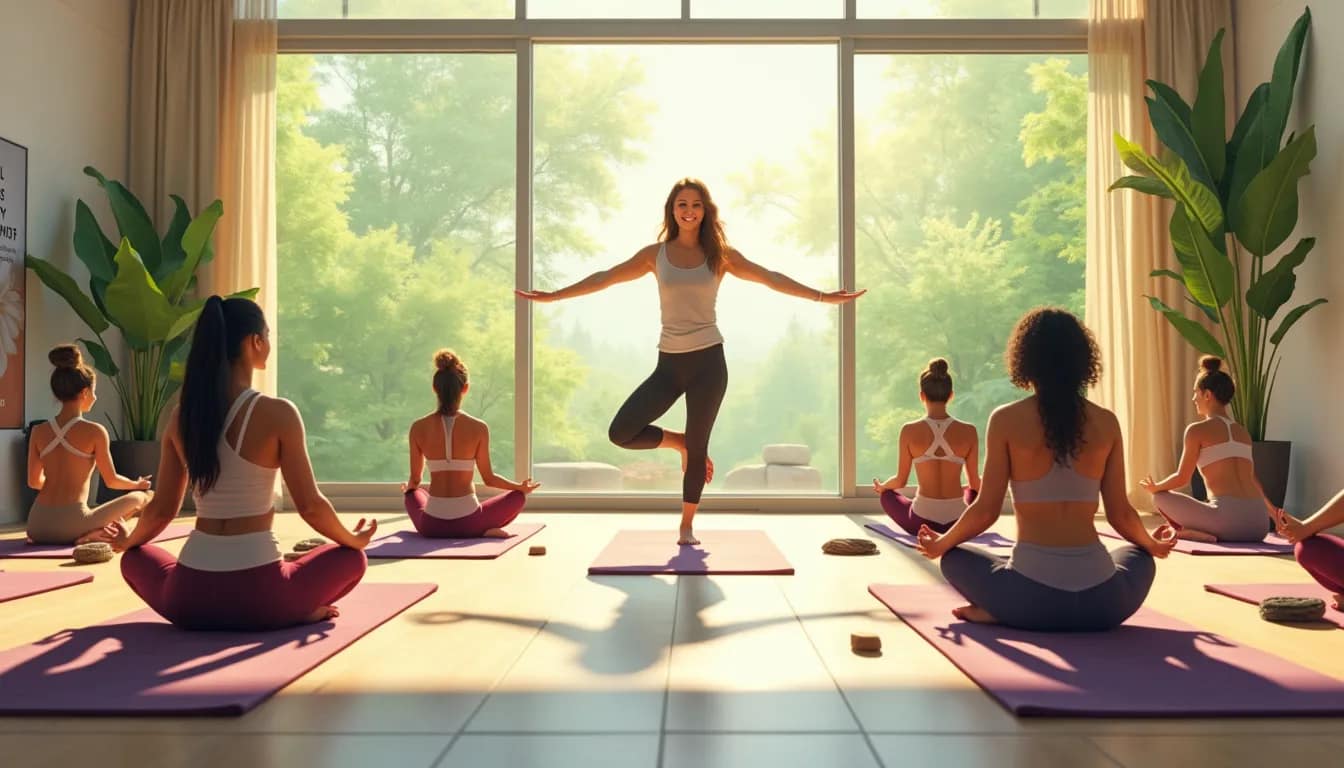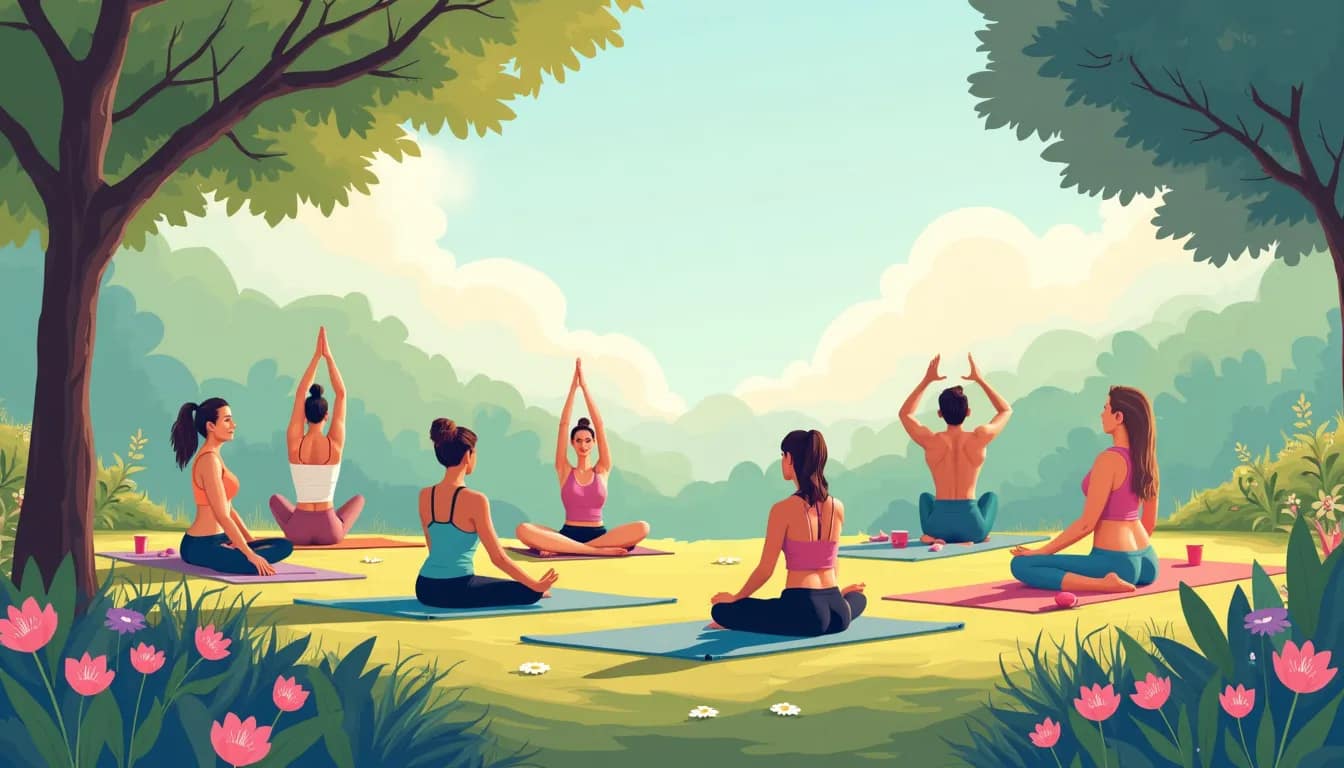Starting a yoga practice can feel like opening the door to a world of tranquility and self-discovery. As a beginner, you might wonder about the right way to step into this serene space without feeling overwhelmed or uncertain. Yoga isn’t just about flexibility and strength; it’s a harmonious blend of mind, body, and spirit that brings a sense of peace and presence into your daily life.
Incorporating yoga into your routine offers countless benefits. From reducing stress and anxiety to improving overall physical health, yoga can be a transformative practice that nurtures both your mental and physical well-being. It’s important to understand that yoga is accessible to everyone, regardless of age, fitness level, or background. Whether you’re looking to calm your mind, increase your flexibility, or build strength, there’s a type of yoga that can help you achieve your goals.
One of the common misconceptions beginners have is that you need to be flexible or fit to start practicing yoga. The truth is, yoga meets you where you are, and every pose can be modified to suit your current abilities. It’s more about listening to your body and progressing at your own pace rather than achieving a perfect pose.
In this guide, we’ll help demystify the process of starting your yoga journey. You’ll learn to choose the right style of yoga that aligns with your personal goals and fitness level, and discover the essential gear and attire you need to begin. We’ll also talk about how to create a comfortable and mindful practice space, which can enhance your yoga experience.
To make your entry into yoga seamless and rewarding, we’ll introduce you to simple poses and sequences perfect for beginners. Breathing techniques and meditation practices will be highlighted, emphasizing their role in grounding your practice. Finally, we’ll offer tips to help you stay consistent and motivated, ensuring that yoga becomes a joyful and enduring part of your life.
Embrace this opportunity with an open heart and a curious mind. Let this journey into yoga enrich your life, bringing tranquility, strength, and mindfulness to your daily routine. Welcome to a beautiful beginning.
Introduction to Yoga for Beginners
The Benefits of Incorporating Yoga into Your Routine
Welcome to the vibrant world of yoga, where every pose is a step toward holistic well-being. Whether you’re seeking to enhance physical flexibility, find inner peace, or simply add a balanced element to your daily routine, yoga offers a myriad of benefits. Practicing yoga regularly can improve your strength, balance, and flexibility. It also nurtures your mental well-being by reducing stress, anxiety, and promoting a sense of calm and clarity.
Imagine greeting each day with a calm mind and an energized body. It’s a beautiful journey that starts with a single pose. Yoga’s benefits are not just physical, but also emotional and spiritual, aligning your entire being in harmony.
Understanding the Basics of Yoga and Mindfulness
Before diving into the ocean of yoga, it’s helpful to understand its roots and basic principles. Yoga is more than just a series of physical exercises; it’s a practice that connects the mind, body, and spirit. Originating in ancient India, yoga combines postures (asanas), breath control (pranayama), and meditation to foster mindfulness and inner peace.
Mindfulness, a core component of yoga, means being fully present and aware in each moment. This can be as simple as focusing on your breath, or as profound as cultivating an awareness of your inner self. When practiced together, yoga and mindfulness create a powerful duo that can transform everyday life.
Let’s try a quick exercise: Sit comfortably and close your eyes. Take a deep breath in, hold for a moment, and then exhale slowly. Feel the breath moving through your body. Repeat this three times, and notice how your mind begins to calm and clear.
Addressing Common Misconceptions About Starting Yoga
As you embark on your yoga journey, you might encounter some common misconceptions that could make you hesitant. Let’s clear those up so you can move forward with confidence and ease.
I’m not flexible enough for yoga. Flexibility is not a prerequisite for starting yoga. In fact, yoga helps you to become more flexible over time. Begin where you are, and let your body naturally progress through consistent practice.
Yoga is only for young and fit people. Yoga is for everyone, regardless of age, size, or fitness level. There are many styles and modifications available to suit all abilities. The key is to find the right approach that resonates with you.
I need a lot of time to practice yoga effectively. Even short sessions can be beneficial. It’s quality, not quantity, that matters most. Start with a few minutes each day and gradually increase as your schedule allows. Consistency is more important than duration.
By addressing these misconceptions, you give yourself the freedom to explore yoga without the weight of unnecessary doubts. You’re opening a door to new experiences, growth, and a deeper connection to yourself.
Preparing for Your Yoga Journey
Choosing the Right Type of Yoga for Your Goals and Fitness Level
Embarking on a yoga journey begins with selecting a style that aligns with your personal goals and physical condition. With numerous styles available, it’s important to find one that resonates with you. For instance, if you’re looking to enhance flexibility and relaxation, Hatha Yoga, known for its gentle pace, may be a good start. Alternatively, if you seek a more vigorous workout, Vinyasa Yoga, with its dynamic flow, might be ideal. Consider Yin Yoga for a deep, meditative practice focusing on connective tissues, or Restorative Yoga to ease stress and promote healing. Take your time to explore different styles through beginner classes or online tutorials to find what feels right for you.
Essential Yoga Gear and Attire for Beginners
To start your yoga journey comfortably, investing in a few essential items can make all the difference. Here’s a simple checklist to guide you:
- Yoga Mat: A non-slip mat is crucial, providing stability and cushioning for your practice. Choose a mat that suits your needs, whether it’s extra-thick for joint support or eco-friendly for sustainability.
- Comfortable Clothing: Opt for breathable, stretchable attire that allows full range of motion. Yoga pants, shorts, or leggings paired with a fitted top can help you move freely and stay comfortable.
- Yoga Blocks: These versatile tools offer support and assist with alignment, making challenging poses more accessible.
- Strap: A yoga strap can help you achieve proper positioning and depth in various stretches, enhancing your flexibility and form.
- Water Bottle: Staying hydrated is essential, so keep a bottle of water nearby to refresh yourself before, during, and after your practice.
Setting Up a Comfortable and Mindful Practice Space
Creating a serene and dedicated space for your yoga practice can immensely enhance your experience, fostering focus and tranquility. Here are some tips to set up a mindful practice space:
- Quiet Environment: Choose a spot in your home where you can practice without distractions. This could be a corner of your bedroom, living room, or even a designated yoga room if space allows.
- Natural Light: If possible, practice near a window to benefit from natural light, which can create a soothing ambiance. If not, use soft, warm lighting to create a peaceful atmosphere.
- Minimalistic Decor: Keep the space clutter-free. A clean, organized environment encourages a clear mind and better concentration. Consider adding a few calming elements, like a plant, a candle, or an inspiring picture.
- Comfortable Flooring: Besides your yoga mat, make sure the floor is suitable for practice. A carpeted area or adding a secondary mat underneath can provide extra cushioning.
- Aroma and Sound: Enhance your practice with soothing scents like lavender or eucalyptus using essential oils or incense. Gentle background music or nature sounds can also help you enter a state of relaxation and mindfulness.
As you prepare for your yoga journey, remember that the most important aspect is to listen to your body and be kind to yourself. Each individual’s path is unique, and it’s perfectly okay to modify poses or take rest when needed. Yoga is not about perfection but about progress and connecting with your inner self. By choosing the right type of yoga, gearing up appropriately, and creating a mindful practice space, you lay a solid foundation for a rewarding and transformative practice.
Getting Started with Your Mindful Yoga Practice
Simple Yoga Poses and Sequences for Beginners
Start your journey with some fundamental poses that are easy and gentle. These poses help you build strength, flexibility, and balance, setting a solid foundation for deeper practice:
- Mountain Pose (Tadasana): This pose teaches proper alignment and can improve posture. Stand tall with feet together or hip-width apart. Roll your shoulders back and take deep breaths, grounding yourself.
- Downward Facing Dog (Adho Mukha Svanasana): It stretches the back and strengthens the arms and legs. Begin on your hands and knees, lift your hips, and straighten your legs.
- Warrior I (Virabhadrasana I): This pose builds strength and stability. From a standing position, step one foot back and bend the front knee. Raise your arms overhead and keep your focus forward.
- Child’s Pose (Balasana): It’s a relaxing pose that gently stretches the back. Kneel on the mat, sit back on your heels, and reach your arms forward, resting your forehead on the ground.
- Cobra (Bhujangasana): This pose helps open the chest and strengthens the back. Lie on your stomach, place your hands under your shoulders, and gently lift your chest upwards.
Importance of Breath Awareness and Meditation
Breath is the essence of yoga. It anchors you to the present moment and creates a bridge between the body and mind. Begin by focusing on your natural breath in each pose and move with the rhythm of your inhales and exhales.
Additionally, incorporating meditation into your practice can enhance mindfulness. Here are a few simple techniques to get you started:
- Mindful Breathing: Sit comfortably, close your eyes, and take slow, deep breaths. Notice the sensation of the breath coming in and going out without trying to change it.
- Body Scan Meditation: Lie down comfortably and bring awareness to different parts of your body, starting from your toes up to your head. Feel the sensations and release any tension you find.
- Guided Meditation: Listen to a guided meditation audio. This can help keep your mind focused and provide structure to your meditation practice.
Tips for Staying Consistent and Motivated in Your Practice
Consistency is key to reaping the full benefits of yoga. Here are some practical tips to help you stay committed:
- Set Realistic Goals: Start small with a few minutes of yoga daily and gradually increase. Celebrate small achievements to stay motivated.
- Create a Routine: Schedule your yoga sessions at a time that works best for you. Whether it’s morning or evening, having a set time can help establish a habit.
- Practice with a Friend: Partnering with a friend can add fun to your practice and provide mutual accountability.
- Join a Class: Sometimes, being in a group setting with a teacher’s guidance can enhance your practice and keep you motivated.
Remember, self-compassion is vital. Your yoga journey is unique, and it’s okay to have days where it’s harder to practice. The most important part is showing up and being kind to yourself.
Now, let’s take a moment to reflect. Have you ever noticed how different your body and mind feel after even a short yoga practice? Take a minute to jot down three feelings or changes you’ve observed.
When you’re ready, return to your day with the awareness that each breath and movement can be a step towards a healthier, more mindful life.
As we draw to a close on this guide to starting a mindful yoga practice, we hope you feel a sense of encouragement and readiness to begin your journey. Yoga, much like mindfulness, is a pathway to greater self-awareness and tranquility, offering profound benefits for both the body and mind. By understanding the basics and dispelling common misconceptions, you now have a solid foundation to start your practice without fear or hesitation.
In preparing to embrace yoga, selecting the right style and gathering essential gear was just the beginning. Setting up a serene, personalized practice space can transform even a small corner of your home into a sanctuary for peace and growth. Remember, your yoga space is a reflection of your inner journey—make it a place where you feel connected and comfortable.
Starting with simple poses and integrating breath awareness and meditation into your routine can set a stable pace for your practice. These elements ground you and enhance the mindfulness aspect of yoga, making each session not just a physical exercise but a rejuvenating experience for your entire being. It’s normal to face challenges and fluctuations in motivation—what’s important is maintaining consistency and compassionately returning to your mat, no matter the obstacles.
Mindfulness in yoga bridges the mind, body, and spirit, creating a holistic approach to well-being. Each movement, each breath, and each moment of stillness within your practice is a step towards knowing yourself more deeply and living more fully. Your journey is unique and personal, and there’s profound beauty in acknowledging and respecting where you are right now.
Our community is filled with individuals who have transformed their lives through mindful yoga practice, and their stories resonate with the authenticity and transformative power that yoga holds. Whether it’s the relief of stress, the boost in physical health, or the deep spiritual insights gained, these shared experiences echo one truth: yoga has the potential to uplift and inspire, touching every aspect of our lives.
So take that beautiful first step onto your mat. Embrace each pose, relish in the mindfulness, and most importantly, be kind to yourself along the way. Your yoga journey is just beginning, and it promises to be as enriching and enlightening as you allow it to be. Welcome to a new chapter of peace, strength, and profound self-discovery. Namaste.



